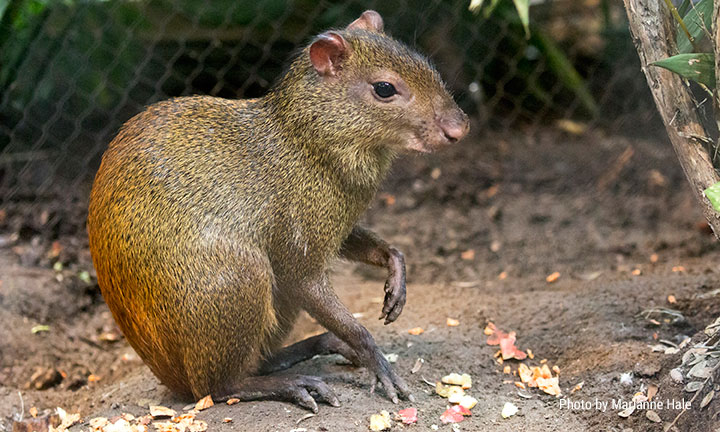Red-rumped agouti
Dasyprocta leporina

At the Zoo
Our red-rumped agoutis can be found in the Puente al Sur.
Fascinating Facts
- They are important seed dispersers in their community and one of the only animals that can crack the tough shell of the Brazil nut.
- They will follow troops of monkeys through the forest and eat fruits that they drop.
- There are 13 different species of agouti and their scientific name “Dasyprocta” means “fuzzy butt.”
- Red-rumped agoutis are able to run within an hour of being born.
Physical Characteristics
Red-rumped agoutis get their name from the reddish fur that covers their backside. They weigh between 6 ½ and 13 pounds and reach up to 2 feet in length. Females are larger than males. Agoutis have short tails, long legs relative to their body size, and sharp, hoof-like claws on their toes, allowing them to run quickly throughout the underbrush of the forest floor.
Like all rodents, agoutis have long incisors that grow throughout their lifetime, but their incisors are notably stronger than those of other rodents.
Habitat/Diet
Red-rumped agoutis are terrestrial and found in rainforests and secondary forests in northern South America in Venezuela, the Guianas, Brazil, and Trinidad and Tobago. They are herbivores, feeding on fruits, nuts, seeds, leaves, and shoots. They will also store food for times of scarcity. Agoutis are important seed dispersers due to their habit of burying stores of food throughout their territories. Some species of trees depend heavily on agoutis for seed dispersal.
Social Behavior
They have a range of alarm or distress calls which include grunts, squeals, and hind foot stamping. Like some other mammals, they also communicate with body posture and distinguish territory through scent marking. Predators include jaguars, ocelots, snakes and raptors.
These diurnal rodents are monogamous and live in pairs or family groups. They often travel and scavenge together to maintain a better lookout for predators. Their gestation period is up to 120 days and litters consist of 1 – 3 young. Both males and females invest energy in helping raise young.
Status In The Wild
This species is listed as Least Concern by IUCN. Local populations are often hunted extensively by humans but the overall population appears to be relatively stable. As long as there is sufficient cover for them to hide in, they seem to survive well even in disturbed habitats.
